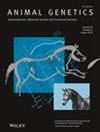Apeksha, Abhishek Mahendra Todkari, Ashok Chaudhary, Mir Mehroz Hassan, Diksha Upreti, Shri Ram Saini, Sheikh Firdous Ahmad, Ashwni Kumar Pandey
下载PDF
{"title":"在金黄色葡萄球菌乳腺炎中解码DNA甲基化:对免疫调节和疾病抵抗的影响","authors":"Apeksha, Abhishek Mahendra Todkari, Ashok Chaudhary, Mir Mehroz Hassan, Diksha Upreti, Shri Ram Saini, Sheikh Firdous Ahmad, Ashwni Kumar Pandey","doi":"10.1111/age.70044","DOIUrl":null,"url":null,"abstract":"<p>Mastitis is a major health and economic threat to the dairy industry, causing massive losses every year worldwide. <i>Staphylococcus aureus</i> is the chief pathogen, responsible for most of the subclinical as well as a considerable portion of the clinical cases. Conventional control strategies, including antibiotic treatment and genetic selection for resistance, have shown limited success due to antimicrobial resistance and low heritability of mastitis resilience traits. This calls for the exploration of novel approaches such as epigenetics, that offers insights into host–pathogen interactions beyond the genetic variations. This review focuses on DNA methylation changes in the mammary gland that occur during <i>S. aureus</i> mastitis. Recent research has identified immune suppression and pathogen persistence in relation with DNA methylation during the disease. The microbe has been reported to alter the methylation status of regulatory regions for many immune genes such as <i>CXCR1</i>, <i>TNF-α</i>, <i>IL6R</i>, <i>IL10</i>, and <i>C3</i>, resulting in dysregulation of immune responses in the host, thereby facilitating pathogen persistence and chronic infection. Along with its own virulence factors, differential DNA methylation status of such genes during infection helps the pathogen to escape host defence, and decreases the intensity of inflammation. Thus, understanding these mechanisms can open new avenues in the field of disease diagnosis, animal selection, and immunotherapy among others. Such an integrative approach offers a revolution in mastitis control strategies, ensuring better health and productivity in dairy animals. © 2025 Stichting International Foundation for Animal Genetics.</p>","PeriodicalId":7905,"journal":{"name":"Animal genetics","volume":"56 5","pages":""},"PeriodicalIF":2.1000,"publicationDate":"2025-09-25","publicationTypes":"Journal Article","fieldsOfStudy":null,"isOpenAccess":false,"openAccessPdf":"https://onlinelibrary.wiley.com/doi/epdf/10.1111/age.70044","citationCount":"0","resultStr":"{\"title\":\"Decoding DNA methylation in Staphylococcus aureus mastitis: Implications for immune regulation and disease resistance\",\"authors\":\"Apeksha, Abhishek Mahendra Todkari, Ashok Chaudhary, Mir Mehroz Hassan, Diksha Upreti, Shri Ram Saini, Sheikh Firdous Ahmad, Ashwni Kumar Pandey\",\"doi\":\"10.1111/age.70044\",\"DOIUrl\":null,\"url\":null,\"abstract\":\"<p>Mastitis is a major health and economic threat to the dairy industry, causing massive losses every year worldwide. <i>Staphylococcus aureus</i> is the chief pathogen, responsible for most of the subclinical as well as a considerable portion of the clinical cases. Conventional control strategies, including antibiotic treatment and genetic selection for resistance, have shown limited success due to antimicrobial resistance and low heritability of mastitis resilience traits. This calls for the exploration of novel approaches such as epigenetics, that offers insights into host–pathogen interactions beyond the genetic variations. This review focuses on DNA methylation changes in the mammary gland that occur during <i>S. aureus</i> mastitis. Recent research has identified immune suppression and pathogen persistence in relation with DNA methylation during the disease. The microbe has been reported to alter the methylation status of regulatory regions for many immune genes such as <i>CXCR1</i>, <i>TNF-α</i>, <i>IL6R</i>, <i>IL10</i>, and <i>C3</i>, resulting in dysregulation of immune responses in the host, thereby facilitating pathogen persistence and chronic infection. Along with its own virulence factors, differential DNA methylation status of such genes during infection helps the pathogen to escape host defence, and decreases the intensity of inflammation. Thus, understanding these mechanisms can open new avenues in the field of disease diagnosis, animal selection, and immunotherapy among others. Such an integrative approach offers a revolution in mastitis control strategies, ensuring better health and productivity in dairy animals. © 2025 Stichting International Foundation for Animal Genetics.</p>\",\"PeriodicalId\":7905,\"journal\":{\"name\":\"Animal genetics\",\"volume\":\"56 5\",\"pages\":\"\"},\"PeriodicalIF\":2.1000,\"publicationDate\":\"2025-09-25\",\"publicationTypes\":\"Journal Article\",\"fieldsOfStudy\":null,\"isOpenAccess\":false,\"openAccessPdf\":\"https://onlinelibrary.wiley.com/doi/epdf/10.1111/age.70044\",\"citationCount\":\"0\",\"resultStr\":null,\"platform\":\"Semanticscholar\",\"paperid\":null,\"PeriodicalName\":\"Animal genetics\",\"FirstCategoryId\":\"99\",\"ListUrlMain\":\"https://onlinelibrary.wiley.com/doi/10.1111/age.70044\",\"RegionNum\":3,\"RegionCategory\":\"生物学\",\"ArticlePicture\":[],\"TitleCN\":null,\"AbstractTextCN\":null,\"PMCID\":null,\"EPubDate\":\"\",\"PubModel\":\"\",\"JCR\":\"Q2\",\"JCRName\":\"AGRICULTURE, DAIRY & ANIMAL SCIENCE\",\"Score\":null,\"Total\":0}","platform":"Semanticscholar","paperid":null,"PeriodicalName":"Animal genetics","FirstCategoryId":"99","ListUrlMain":"https://onlinelibrary.wiley.com/doi/10.1111/age.70044","RegionNum":3,"RegionCategory":"生物学","ArticlePicture":[],"TitleCN":null,"AbstractTextCN":null,"PMCID":null,"EPubDate":"","PubModel":"","JCR":"Q2","JCRName":"AGRICULTURE, DAIRY & ANIMAL SCIENCE","Score":null,"Total":0}
引用次数: 0
引用
批量引用


 求助内容:
求助内容: 应助结果提醒方式:
应助结果提醒方式:


